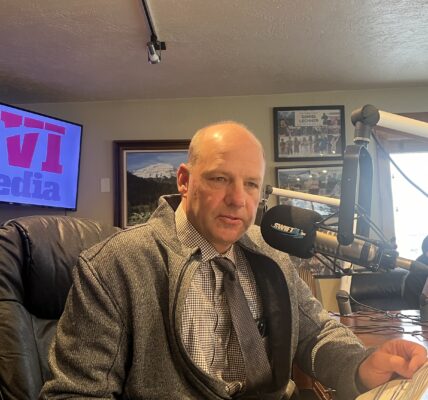By Hannah Shields
Wyoming Tribune Eagle
Via- Wyoming News Exchange
CHEYENNE — Elle Sanderson’s son, Raylan, is diagnosed with a rare genetic disorder, SYNGAP1, that affects his ability to communicate.
Two years ago, right before school let out for the summer, his school refused to let him take home his augmentative assistive communication (AAC) device. The AAC is an iPad her son used during the school year to communicate with his teachers.
“I didn’t know why it was wrong; it just sounded terrible to me,” Sanderson said.
She called several people at the school and told them it was “wildly inappropriate … to take a student’s voice away for an entire summer.” Sanderson said she refused to jump through hoops with her health insurance company just to get another AAC device.
Not getting anywhere, the concerned mother reached out to Uplift, a statewide nonprofit advocacy group for children with behavioral health issues, for support. Sanderson had worked with the organization previously while her son was at STRIDE Learning Center, a local child development center.
Sanderson won the fight against the school district, but she wanted to keep fighting for other parents in similar situations. That’s how she came to work for Uplift before opening her own advocacy company, Rising Star, in August 2023.
Wyoming’s K-12 schools have seen an 8% increase in special education students since 2018, but a 10% decrease in fully certified special education instructors. To fill vacant spots, inexperienced instructors are hired to teach these classes on the promise they’ll work toward a degree in special education.
Local advocates, however, argue Laramie County School District 1’s special education services are “ill-equipped” to handle students with behavioral health issues.
In the past year, Sanderson served more than 300 families across Wyoming. Her goal is to help other parents of developmentally disabled children understand their rights under the Individuals with Disabilities Education Act.
“Child find,” under IDEA law, requires states and local educational agencies to identify, locate and evaluate all children with disabilities, “regardless of the severity of the disability.”
Once a child is identified, an Individualized Education Program (IEP) plan is put together during a meeting with the parents and special education providers. Schools are responsible for meeting the guidelines in these plans.
Sanderson said Wyoming’s school districts are “absolutely not” equipped to support students with behavioral health issues.
“We have special education teachers that are not certified special education teachers in this district,” Sanderson said. “And the law states that you have to be a special education certified teacher to deliver instruction.”
Data from the Wyoming Department of Education obtained by the Wyoming Tribune Eagle shows a 60% increase in autistic children in early childhood education and a 19% increase in autistic children in K-12 schools since 2018.
But school districts across the nation and Wyoming are struggling to find qualified special education instructors.
Fewer certified teachers, more special ed students
The 2023-24 school year had 1,054 more students enrolled in special education services than in the 2018-19 school year, according to statewide data. Specifically, there was an increase in the number of students diagnosed with autism (19% increase), a learning disability (6% increase) and multiple disabilities (23% increase).
LCSD1 Special Services Director Stacey Kern said developmental disability diagnoses are on the rise across the nation, with behavioral health being “a big one.” With a lack of social services available in Wyoming, it falls to the education system to address these behavioral health issues, she said.
“We have pretty intense behaviors at a level that we’ve never seen before in public education,” Kern said.
Statewide data shows a steady increase in the number of teachers leaving special education, either for general education or non-teaching positions. The same data also shows that fewer general education teachers are moving into special education teaching positions.
WDE data analytics supervisor Vince Meyer hesitated to draw strong conclusions based on this data, due to complex variability.
The gap between the percentage of fully certified special ed teachers and not fully certified teachers shrank significantly in the 2023-24 school year.
Six years ago, 4.4% of special education teachers were not fully certified. Last school year, that number jumped to 13.7%.
This trend is also reflected in Wyoming pre-kindergarten schools. In the 2023-24 school year, 31% of special ed teachers were not fully certified, which is 16 percentage points higher than in 2018-19.
Low morale, burnout
Cheyenne Teachers Education Association President Dylan Ford said he’s worried about the level of burnout that special education teachers are experiencing, especially those who are hired on an exception authorization (EA) license.
Individuals eligible for an EA must have a bachelor’s degree in some field and are required to work toward a master’s degree in special education, according to Kern.
She said this was the only way the district could fill otherwise vacant spots. EA teachers are directly supervised by a certified special education teacher, she said, and can’t function independently.
“People are learning the job as they’re doing the job, and that is a little bit challenging,” Kern said. “It’s stressful for the educator who is on an exception authorization.”
Ford said the EA licenses are a good idea, but he has also heard concerns from teachers who are in the program.
“It’s a pretty big lift for the teachers,” Ford said in an email to the WTE. “Being a teacher alone requires an enormous amount of work. Being a special education teacher basically adds a second job on top of that.”
Special education teachers work with students who have “very high behavioral and academic needs,” Ford said. In addition, they’re also responsible for creating legal documents and holding regular meetings with parents — all while they work toward a master’s degree and attend district training.
“I really worry about burnout with these teachers,” Ford said.
Struggle to modify behavior issues
Uplift Executive Director Michelle Heinen said she’s disappointed in the way both early child development centers and school districts across the state have dealt with misbehavior in children. Instead of teaching kids how to correct their behavior, schools are choosing to suspend more and more children, she said.
“We’re seeing, still, a ton of suspensions, a lot of exclusions, a lot of really punitive discipline that does nothing but pile up,” Heinen said.
A big issue for parents is getting calls from the school to pick up their child for behavioral issues, Heinen said. These absences from school will often go unrecorded, and it makes it difficult for a parent to prove their child is missing school for behavioral reasons.
“My teacher heart just hurts,” Heinen said. “Excluding kids makes them feel less part of the fabric of the school. That’s only the way to escalate behaviors.”
Heinen said she’s seen students pick up $800 worth of tickets from school resource officers, who she believes should also be trained on behavior intervention and de-escalation techniques.
“How is that helping the kid?” Heinen said. “If there’s not any intervention, and it’s just pure punitive, I don’t think we’re going to dig ourselves out of this hole.”
It’s common for a parent to pick up their child because school staff is struggling to regulate the student’s behavior, Sanderson said. These “off the book” suspensions are a burden on both the parent and the child.
“If we don’t get suspension paperwork, it’s really hard to say that he can’t read because the school kicked him out 27 times,” Sanderson said. “They’re missing instruction, but there’s no paperwork to show why.”
Sanderson said getting the paperwork is crucial for determining the next steps to make up for missed instruction time in class.
Wyoming law requires a child to receive a hearing after 10 consecutive suspensions. These hearings are a chance for a child and their parents to meet with an interventionist and explore behavioral health reasons for why the child is acting up.
“Say they’re not eligible for special education, but they keep getting sent home for the same behavior,” Sanderson said. “If I come in as an advocate, and I say, ‘Well, the data says that he’s been removed from school 15 times, and nobody’s done an MDR (Manifestation Determination Review) meeting or even requested that he be evaluated,’ the school’s now failed their ‘child find’ obligation.”
Support in the classroom
Ford noted that there’s “a very real shortage of paraprofessionals.” Expectations for IEPs have increased and scrutiny under the WDE has intensified, he said. Without paras in the classrooms, the burden of these duties falls on the educator.
“There are legitimate reasons this scrutiny is happening, but the workload for these educators has increased,” Ford said. “This leads to burnout, people resigning, and then if those positions don’t fill, the workload of the remaining teachers increases. It’s a vicious cycle.”
Both Heinen and Sanderson said paraprofessionals, aides who support teachers in special education, need to earn a higher wage.
According to ZipRecruiter, the average wage for a paraprofessional in Wyoming is $17 an hour.
“They’re asked to put up with being hit (and) spit on, change diapers, work with medical equipment — when they can definitely make more in fast food,” Heinen said. “And not that there’s anything against fast food, but our children are our future, and we need to invest accordingly.”
All the same, Heinen noted there were several improvements made by LCSD1 over the last two years. It reformed some of the classrooms to add Low Incidence Disability (LID) classrooms for students with significant cognitive disabilities or complex access needs, as well as added behavior interventionists to all the elementary schools.
District officials are also currently working on adding board-certified behavior analyst therapists to some of the low-incidence rooms, so more kids can receive one-on-one support.
“I feel like at least this district has worked hard to address some of the behavior fallout,” Heinen said.
There’s also a few different incentives in place for those who go into special education. The district offers a tuition reimbursement program that pays people to receive their special education degree and work in one of its schools. General education teachers are given a stipend if they choose to get certified in special education.
CTEA recently asked the district to form a working committee in response to burnout concerns within the special education community, Ford said. The committee would be composed of educators and district administrators to address caseload issues, responsibilities and support systems.
Ford said he hopes the committee will propose new support systems during negotiations this year, and they get passed for next year.
“These are some difficult issues, and the process will take awhile,” Ford said. “But I think we can make a real impact for these educators in the long term.”





